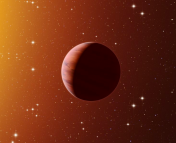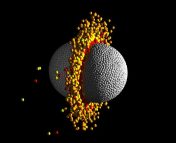Title: Exoplanet characterisation in the longest known resonant chain: the K2-138 system seen by HARPS
Authors: T. A. Lopez, S. C. C. Barros, A. Santerne, M. Deleuil et al
First Author’s Institution: Aix Marseille University
Status: Accepted to Astronomy & Astrophysics, open access on arXiv
A game of musical exoplanets
In the song Twinkle, Twinkle, Little Star, the interval between the first two notes and the second two notes is a perfect fifth. What in the world does this have to do with astronomy? It turns out that this is the same ratio as the orbital frequencies of planets in the K2-138 solar system.
The K2-138 system was first discovered by citizen scientists through the Exoplanet Explorers program in 2018. From the lightcurve of the star, these scientists noted dips in brightness indicating four transiting planets. Upon a more detailed inspection of the lightcurve, two more planets were detected.
Adding to the excitement of identifying a system with so many planets, the five inner planets were found to be in a resonant chain. This means that the orbital periods of the planets are successive ratios of each other, in this case following a 3:2 pattern (if the innermost planet has a 2-day period the next would have a 3-day period). The periods of the first and second K2-138 planets are 2.35 and 3.56 days, which is very close to 3:2; the second and third planets have a similar ratio, and so on. This makes K2-138 the longest known 3:2 resonance chain—and also makes it pitch-perfect in its rendition of Twinkle, Twinkle (see Figure 1).
Today’s paper is a follow-up analysis of the K2-138 system using spectral data from the HARPS spectrograph. This radial velocity (RV) data allows the authors to characterize the system in detail, including the masses and densities of the planets.
Radial velocities: the major key to planetary masses
From the discovery data, researchers determined the periods and radii of the planets in the system, as this is the information contained in transit lightcurves. To learn more about the system’s properties, other measurements were needed. The authors took spectra of K2-138 over 79 nights to get radial velocity measurements, which reveals information about the planet’s mass.
RV observations detect the small gravitational tug of a planet on its star as it orbits. This causes the star to wobble back and forth slightly. If we observe the system at the proper angle, we will see this back-and-forth as a change in the velocity of the star: it is redshifted as the star is pulled away from us, and blueshifted as it is pulled towards us. These movements shift the observed stellar spectral lines back and forth over time. The larger the shift in the lines, the more massive the planet, as a massive planet tugs more strongly on its star.
The authors performed a joint Bayesian analysis of the transit lightcurves and radial velocity data as well as the spectral energy distribution of the system. This allowed them to determine the properties of the planets simultaneously. The left side of Figure 2 shows the radial velocity measurements, “folded” around each planet’s period in a given panel to reveal the periodic tugs from each planet. The right side shows the lightcurve for that planet, also folded to show the period of each planet.
From Figure 2, it is clear that planet e has the largest radial velocity, meaning it is the most massive. Planets f and g show very weak radial velocities. All planets show clear transit signals, though planet g has poor coverage due to the pipeline.
Notes from the K2-138 planets
From their analysis of the radial velocities and transits, the authors derived the masses and radii of the six planets. These are shown in Figure 3 on a radius vs. mass diagram. The mass and radius determine the density, which can point to the composition of the planet. The first five planets range from Earth to Neptune-like densities, and are predicted to have rocky cores and significant atmospheres made up of volatile elements. The authors were only able to place upper limits on the masses of the two outermost planets, due to the stellar activity level (see this astrobite for more on RVs and stellar activity).
There are few low-mass planets with both precisely measured masses and radii, so this characterization adds significantly to our statistics of these types of systems. Additionally, multi-planet systems allow for the study of how different types of planets form in similar environments.
Beyond characterizing this interesting multi-planetary system, the authors discuss what K2-138 can teach us about exoplanet measurements and planet systems more broadly. It is a prime candidate for follow-up observations to study transit-timing variations (TTVs)—deviations from strict periodicity in the transits of planet due to the gravitational pull of other planets in the system. The authors make predictions that these will be detectable in K2-138 by the planned space telescope CHEOPS, allowing for a direct comparison of the RV and TTV methods. Additionally, multi-planet systems with 3:2 resonant chains, like K2-138, are predicted to host a higher fraction of co-orbital planet pairs, planets that share the same orbit. This rhythmic planet system is a great place to go looking for these pairs.




